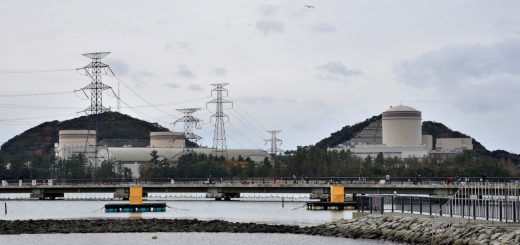Government Approves Kyushu Electric’s Pluthermal Plan Nuke Info Tokyo No. 108
On September 7th the Minister of Economy Trade and Industry approved Kyushu Electric Power Company’s pluthermal1 plan for Genkai-3. This followed favorable reports by the Nuclear Safety Commission (NSC) on 29 August and by the Atomic Energy Commission (AEC) the following day. The NSC and AEC reviews were double checks of an ealier investigation by the Ministry of Economy Trade and Industry (METI). They bring to an end the government’s examination of Kyushu Electric’s pluthermal plan. The final hurdle is the ‘prior understanding’ of the prefectural and local governments.
Japan’s pluthermal plan was published by the Federation of Electric Power Companies (FEPCO) in February 1997 at the request of the central government. This request was made in consideration of the serious setback to the fast breeder reactor (FBR) program following the accident at the Monju FBR in 1995. The FEPCO plan was to fabricate the plutonium extracted from spent nuclear fuel into MOX fuel. Japanese power companies have contracts with reprocessing companies in France and the UK to reprocess their spent fuel. The MOX fuel would be fabricated in France and the UK, shipped to Japan and loaded into 16-18 reactors over the period from 1999 to 2010. The amount to be consumed by each power company was based on the amount specified in their contracts and Tokyo and Kansai Electric Power Companies (TEPCO and KEPCO) were to be the first to load MOX fuel. They were to load it from 1999, followed by the other companies early in the decade beginning in 2000. However, to date not a single reactor has introduced pluthermal.
MOX fuel for TEPCO was sent to Fukushima and Niigata and MOX fuel for KEPCO was sent to Fukui. However, in the KEPCO case it was discovered that the UK manufacturer (BNFL) had falsified quality control data. This was a major setback for the pluthermal plan. In 2002, this MOX fuel was returned to the UK without being loaded into reactors. After that, negotiations were commenced with France’s COGEMA for a contract to manufacturer MOX fuel. However, in August 2004, when the negotiations had only proceeded to the stage of a provisional contract, a pipe ruptured at the Mihama-3 reactor killing five people. As a result, KEPCO’s quality control ability was called into question and the contract was not finalized.
In the case of TEPCO, in 2001 a citizens’ referendum was held in Kariwa Village, Niigata Prefecture about the pluthermal plan and the majority voted against. (Kariwa Village hosts TEPCO’s Kashiwazaiki-Kariwa NPP.) Then in August 2002, it was discovered that data from periodic inspections at TEPCO’s NPPs had been altered and Niigata and Fukushima Prefectures both rescinded their ‘prior understanding’ for pluthermal.
With the two leading power companies’ pluthermal plans derailed and the Rokkasho Reprocessing Plant scheduled to begin active trials (using spent fuel) in December, Kyushu Electric and Shikoku Electric were under pressure to submit applications for permission to use MOX fuel, in order to be able to show some progress in the pluthermal program. They plan to introduce pluthermal by 2010, while the Rokkasho Reprocessing Plant is scheduled to begin operations in 2007, so it’s a tight schedule. In addition, to induce local and prefectural governments to accept pluthermal, in 2004 METI introduced new subsidies. Apparently consideration is being given to further raising these subsidies.
For its safety review of Genkai-3, NSC decided not to set up an expert review panel to conduct a detailed investigation. Instead it left the judgment to three of its commissioners. NSC said that it was unnecessary to conduct an expert investigation, because the use of MOX fuel in Genkai-3 would be the same as that previously intended for KEPCO’s Takahama-3&4 reactors. However, the power output of Genkai-3 is higher at 1180 MW (Takahama 3&4 are 870 MW) and the core design is different, so 151 groups and 114 individuals demanded a rigorous expert investigation and an opportunity for public comment. They also pointed out that compared to overseas, the plutonium content would be quite high. Compared to 3.1-4.6% plutonium in France MOX fuel assemblies, Genkai-3 assemblies will contain 6.1%. As a result, the plutonium could become unevenly distributed (plutonium spots), increasing the risk of damage to the fuel. There is also concern that there is nowhere to put the spent MOX fuel and that it may be stored long-term at the reactor site. This is because even if the Rokkasho Reprocessing Plant starts up, it is not capable of reprocessing MOX fuel.
In Kysushu there has been a wide range of activities in opposition to pluthermal, including protest flotillas on the sea around Genkai, petitions and public debates. Also, resolutions against pluthermal have been passed by local councils neighboring Genkai. Now that the government has approved pluthermal for Genkai-3, it is very important to have a strong follow-up to the protests carried out so far.
Hideyuki Ban (CNIC Co-Director)
Post Script
On September 12th and 13th respectively, Chugoku Electric and Chubu Electric informed their prefectural and local governments of their intention to introduce pluthermal by 2010. The next step will be for them to submit a formal application for approval to the central government.
Clearly these moves are an attempt to justify the impending commencement of active trials at Rokkasho. It is highly likely that the same imperative will also induce Tohoku Electric, Hokuriku Electric and Hokkaido Electric to announce pluthermal plans in the near future.
Meanwhile, there is strong local opposition to pluthermal at Chubu Electric’s Hamaoka plant, because it is in a major earthquake zone.
1. The term ‘pluthermal’ refers to the use of plutonium in the form of ‘mixed oxide’ (MOX) fuel in light water reactors.

